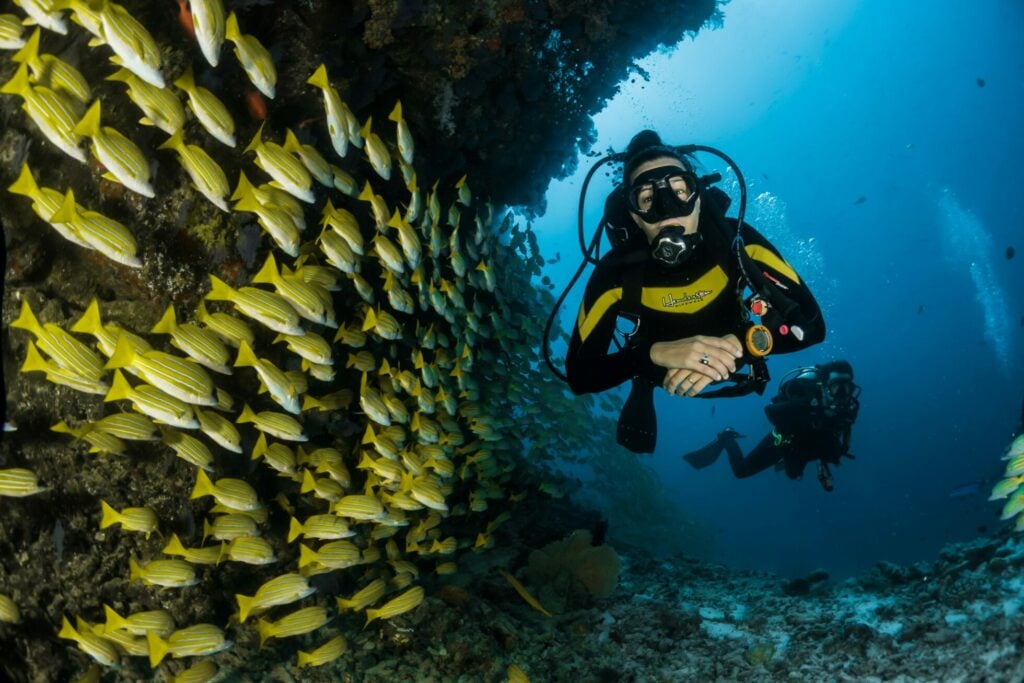Discover the crisis of endangered marine animals, its consequences, and conservation efforts, including the work of marine conservation programs with GVI.
Petrina Darrah
Posted: May 18, 2023

GVI
Posted: July 1, 2024
Naifaru Island in the Maldives is a top destination for ocean lovers. With its clear waters and diverse marine life, it’s the perfect place for diving and snorkelling. Let’s dive into what makes Naifaru’s underwater world so unique, from the best spots to the amazing species you can encounter.
Naifaru’s marine ecosystem is incredibly diverse and vibrant. Coral reefs, often called the rainforests of the sea, are the backbone of this underwater paradise. They provide shelter, food and breeding grounds for countless marine creatures, from tiny invertebrates to large fish and mammals.
Just off the coast of Naifaru Island, Naifaru Reef is a must-visit for divers and snorkelers. This reef is teeming with a stunning variety of corals and fish, creating a vibrant underwater landscape.
The best time to explore Naifaru Reef is during the dry season, from November to April, when visibility is at its peak and the waters are calm. Expect to see everything from schools of colourful fish to the occasional sea turtle gliding by.
The Blue Hole is a unique underwater formation that attracts divers from around the world. Its deep, circular shape and dramatic walls create an awe-inspiring dive experience. The Blue Hole is home to a diverse range of marine life, including colourful fish, curious sea turtles, and even reef sharks.
Diving here requires some experience due to the depth and unique features, so it’s recommended to dive with a guide if you’re unfamiliar with the area.
For those staying on Naifaru Island, the House Reef offers convenient access to the underwater world. This spot is perfect for both beginners and experienced snorkelers. The House Reef boasts a variety of corals and fish species, providing endless opportunities for exploration. The shallow waters make it an ideal spot for families and novice snorkelers to enjoy the marine life up close.

Naifaru’s reefs are home to a dazzling variety of fish. Common sightings include parrotfish, angelfish, and butterflyfish. Look out for the rare Napoleon wrasse, known for its striking appearance and vibrant colours. You might even spot clownfish, just like Nemo.
Dolphins often visit the waters around Naifaru. Watching them leap and spin is a real treat. Occasionally, you might even spot larger marine mammals like whales, making for a truly awe-inspiring experience.
Sea turtles, including green and hawksbill turtles, are a common sight around Naifaru. These gentle creatures are fascinating to watch as they glide through the water. Manta rays and eagle rays are also prevalent, moving gracefully through the ocean.
The reefs around Naifaru are home to various invertebrates like octopuses, starfish and sea urchins. These creatures play vital roles in maintaining the health and diversity of the reef ecosystem.
Protecting Naifaru’s marine life is a big deal. Conservation efforts focus on safeguarding coral reefs and marine species. You can help by practising responsible diving and snorkelling: avoid touching corals, don’t disturb marine animals and support local conservation projects and eco-friendly tours.
Naifaru Island offers an extraordinary glimpse into the diverse marine life of the Maldives. From vibrant coral reefs to a variety of marine species, there’s something for every ocean lover.
Experience the true essence of island life by volunteering in the Maldives with GVI. You’ll work alongside marine biologists to care for and rehabilitate injured sea turtles at the Maldives’ first floating marine centre.
Make a real difference while gaining hands-on experience in marine conservation. Live just two minutes from the beach in the heart of Naifaru. After a rewarding day, relax at the volunteer house, explore the town or enjoy a sunset stroll.
Ready for an unforgettable adventure? Join our sea turtle conservation program today!
Discover the crisis of endangered marine animals, its consequences, and conservation efforts, including the work of marine conservation programs with GVI.
Petrina Darrah
Posted: May 18, 2023